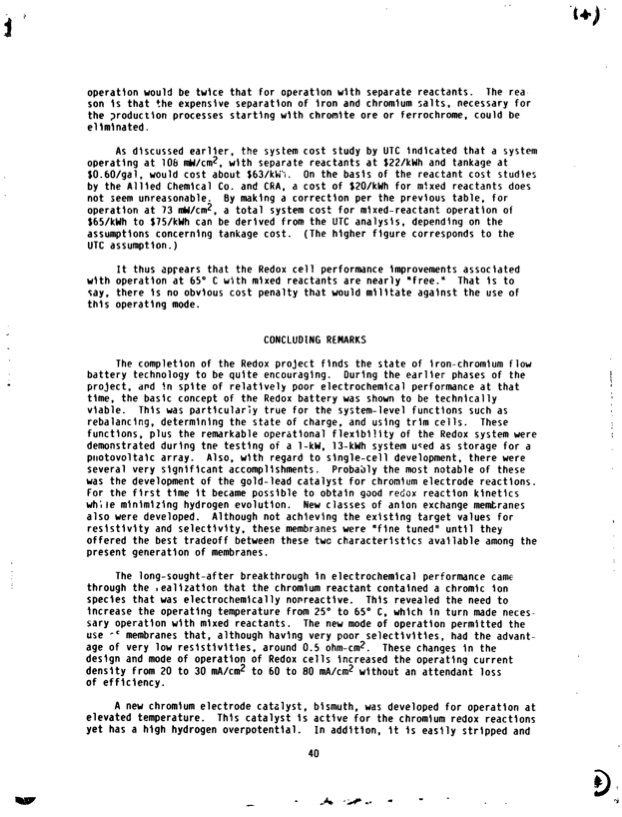
PDF Publication Title:
Text from PDF Page: 043
operatlon would be twice that for operation with separate reactants. The rea- son is that the expensive separation of iron and chromlum salts, necessary for the >roductlon processes starting with chromite ore or ferrochrome, could be e llmlnated. As discussed earlier, the system cost study by UTC indicated that a system operating a t 108 rnW/cm2. wlth separate reactants a t $22/kWh and tankage at $0.6O/gal, would cost about $63/kbiq-I. On the basis of the reactant cost studies by the Allied Chemical Co. and CRA, a cost of $2O/kWh for m!xed reactants does not jeem unreasonable. By making a correction per the previous table, for operatlon a t 73 rnW/cm2, a t o t a l system cost f o r mixed-reactant operatlon of $bS/kWh to $75/kWh can be derived from the UTC analysis, depending on the assumptions concerning tankage cost. (The higher figure corresponds to the UTC assumption.) It thus aprears that the Redox cell performance improvements associated with operation at 65" C ulth mixed reactants are nearly 'free." That Is to tay, there is no obvious cost penalty that would militate against the use of this operating mode. CONCLUDING REMARKS The completion of the Redox project flnds the state of Iron-chromium flow battery technology to be quite encouraging. During the earlier phases of the project, a ~ d!n spite of relatively poor electrochemical performance at that time, the baslc concept of the Redox battery was shown to be technically viable. This was particulariy true for the system-level functions such as rebalanclng, determining the state of charge, and uslng t r l m cells. These functions, plus the remarkable operational flexibi!lty of the Redox system were demonstrated during tne testing of a 1-kW, 13-kWh system uced as storage for a pt~otovoltaicarray. Also, wlth regard t o single-cell development, there were several very significant accomplishments. Probably the most notable of these was the development of the gold-lead catalyst for chromium electrode reactions. For the first time it became possible to obtain good redox reaction kinetlcs wh; re mlnlmlzing hydrogen evolution. New classes of anlon exchange memtranes also were developed. Although not achieving the existing target values for resistivity and selectivity, these membranes were "fine tuned" until they offered the best tradeoff between these twc characteristics available among the present generation of membranes. The long-sought-after breakthrough i n electrochemical performance came through the lealization that the chromium reactant contalned a chromic ion species that was electrochernlcally nonreactive. This revealed the need to increase the operating temperature from 25" to 65" C, which In turn made neces- sary operation with mlxed reactants. The new mode of operation permitted the -' membranes that, although having very poor selectivities, had the advant- use age of very low resistivities, around 0.5 ohm-cm2. These changes I n the design and mode of operatlon of Redox cells increased the operating current density from 20 t o 30 mA/cm2 t o 60 t o 80 mA/cm2 without an attendant loss of efficiency. A new chromlum electrode catalyst, bismuth, was developed for operation at elevated temperature. This catalyst Is active for the chromlum redox reactions yet has a high hydrogen overpotential. I n addition, i t i s easily stripped andPDF Image | NASA Redox Storage System Development Project

PDF Search Title:
NASA Redox Storage System Development ProjectOriginal File Name Searched:
19850004157.pdfDIY PDF Search: Google It | Yahoo | Bing
CO2 Organic Rankine Cycle Experimenter Platform The supercritical CO2 phase change system is both a heat pump and organic rankine cycle which can be used for those purposes and as a supercritical extractor for advanced subcritical and supercritical extraction technology. Uses include producing nanoparticles, precious metal CO2 extraction, lithium battery recycling, and other applications... More Info
Heat Pumps CO2 ORC Heat Pump System Platform More Info
| CONTACT TEL: 608-238-6001 Email: greg@infinityturbine.com | RSS | AMP |